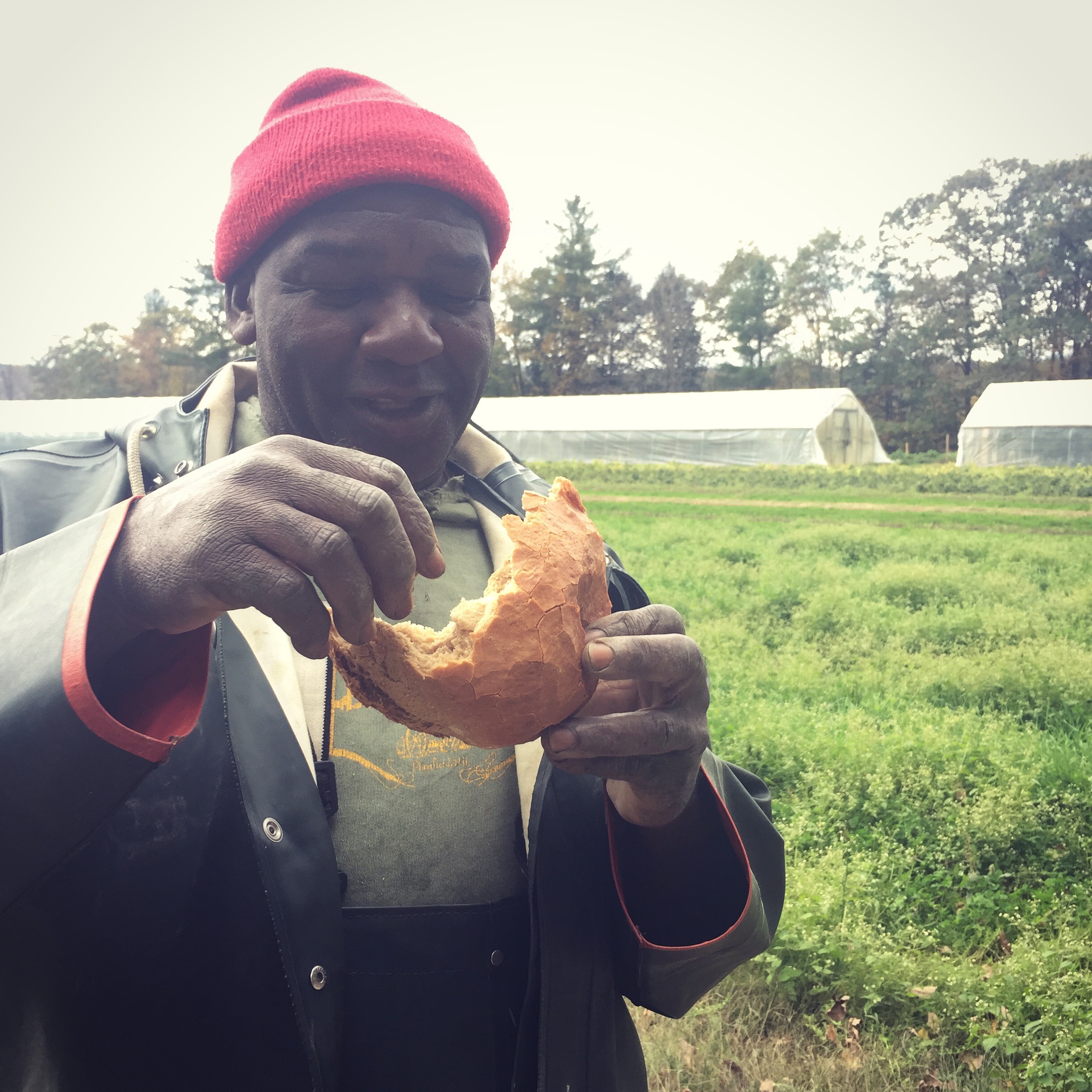Pick List:
potatoes - long island cheese pumpkin - asian greens - onion - beets - turnips -
radishes - garlic - cilantro - brussels sprouts - eggs
KITCHEN LIST:
Preserves!! (jam or kimchi or hot sauce) & multigrain bread
It should come as no surprise to anyone that I am again, writing from a warm office on a very rainy Monday afternoon. When it comes to doing any sort of office work, I typically put it off and off and feel unsettled at a computer… But this October, due to all the rain, bring it. This weather is out of control. All we can do at this point, is hope for sunshine before Winter kicks in and the light levels drop incredibly low. As far as the fields are concerned, they are soaking wet with standing water here and there. We are all pretty over it.
Our big goals for the upcoming week are to plant next year’s garlic crop, dig the rest of the carrots, and basque in whatever sort of sun that will hopefully shine.
Also, if any of you are interested in planting your own garlic now is the time!! Singulate your garlic cloves and plant
in a sunny location with rich, well-drained soil. Set cloves - root side down 4-6" apart in rows 1-1/2 to 2' apart, and cover with 1-2" of soil. Next, put down 6" of mulch for winter protection. Look for teeny tiny garlic shoots come late spring/early summer let the plant grow tall shooting out a scape, but trim back before the scape flowers. Leave in the ground a few more weeks post garlic scape harvest to really size up. That all said, if you happen to lose this sheet of paper between now and Summer 2019- just follow us on instagram to figure out when we harvest scapes to harvesting bulbs. And yes, you can use your garlic from CSA or any local farm to plant out.
And lastly, on the garlic front- plant your crop near your house to keep vampires at bay- Happy Halloween yall!
TIPS - TRICKS - RECIPES
Author Notes: This recipe will add much-needed spark to your winter diet (and your Thanksgiving spread). Adapted lightly from Momofuku by David Chang and Peter Meehan (Clarkson Potter, 2009) —Genius Recipes
Serves: 4 to 6, as a side - Prep time: 20 min - Cook time: 35 min
Roasted Brussels Sprouts
2 tablespoons very thinly sliced cilantro stems, plus 1/2 cup leaves 3 tablespoons chopped mint
2 pounds brussels sprouts (smaller ones are better)
2 tablespoons grapeseed or other neutral oil (or 3 cups if frying instead of roasting)
Fish Sauce Vinaigrette
½ cup fish sauce (adjust to taste -- some fish sauce brands are saltier) ¼ cup water
2 tablespoons rice wine vinegar
2 tablespoons lime juice
¼ cup sugar
1 garlic clove, minced
2 red bird’s-eye chiles, thinly sliced, seeds intact
Roasted Brussels Sprouts
Combine the vinaigrette (below), cilantro stems, and mint in a bowl, and set aside.
Peel away any loose or discolored outer leaves, trim the dry end of the stems with a knife, and cut the sprouts in half. Cut any especially large ones in quarters. Do not wash, especially if frying the sprouts. If roasting, and you must, dry very well.
To roast the brussels sprouts (recommended): Heat the oven to 400 degrees F. Heat 2 tablespoons grapeseed oil (or just enough to evenly coat the bottom of the pan) in 2 oven-safe wide skillets (12 to 14 inches) over medium heat. When the oil slides easily from side to side of the pan, add the brussels sprouts cut side down. When the cut faces of the sprouts begin to brown, transfer the pan to the oven to finish cooking, about 15 minutes. Alternately, if you don't have 2 large skillets or are cooking more sprouts for a larger crowd, roast them in the oven: toss them with 1 tablespoon of oil per pound and spread them on a baking sheet, cut sides down. Roast in the oven, checking for browning every 10-15 minutes, tossing them around with a spatula only once they start to brown nicely.The sprouts are ready when they are tender but not soft, with nice, dark brown color.
To fry the brussels sprouts: Heat 1 1/2 inches of oil in a deep saucepan over medium-high heat until a deep-fry or instant-read thermometer registers 375°F. Line a plate with paper towels. Fry in batches that don’t crowd the pan -- be careful, these will pop and spatter. Brussels sprouts will take about 5 minutes: when the outer leaves begin to hint at going black around the edges—i.e., after the sprouts have sizzled, shrunk, popped, and browned but before they burn—remove them to a paper towel–lined plate or tray.
Serve warm or at room temperature. When ready to serve, divide the brussels sprouts among four bowls (or serve it all out of one big bowl), top with the dressing to taste and cilantro leaves, and toss once or twice to coat.
Fish Sauce Vinaigrette: Combine the fish sauce, water, vinegar, lime juice, sugar, garlic, and chiles in a jar. Taste; If too salty, add more water and/or lime juice. This vinaigrette will keep for up to a week in the refrigerator.
Yall, this recipe below, is an adaptation to one of my very favorite winter recipes that is found in Nigel Slater’s book, TENDER… Sadly, we did not grow lemongrass this year, so if you can get your hands on some please do so. Otherwise, you should be set for the other ingredients.
Also noteworthy, The squash you are getting today is called, Long Island Cheese. It is in fact the very best tasting winter squash on the planet. Roast, and use like crazy.
AND LASTLY, the brussels recipe was sent to me by my best friend who happens to be one of the best cooks i know… enjoy!






















